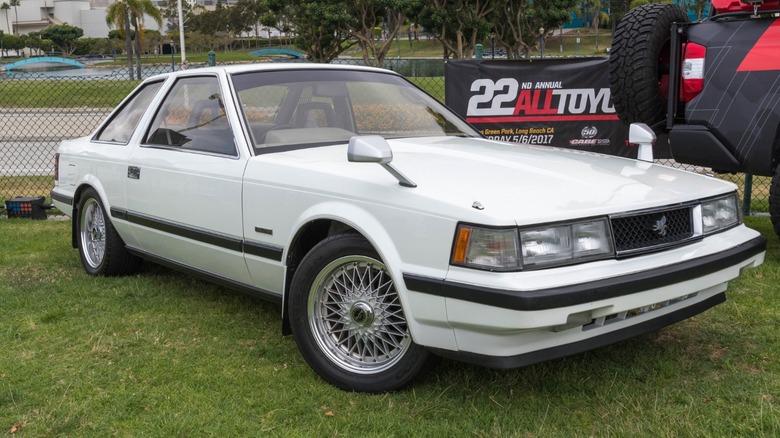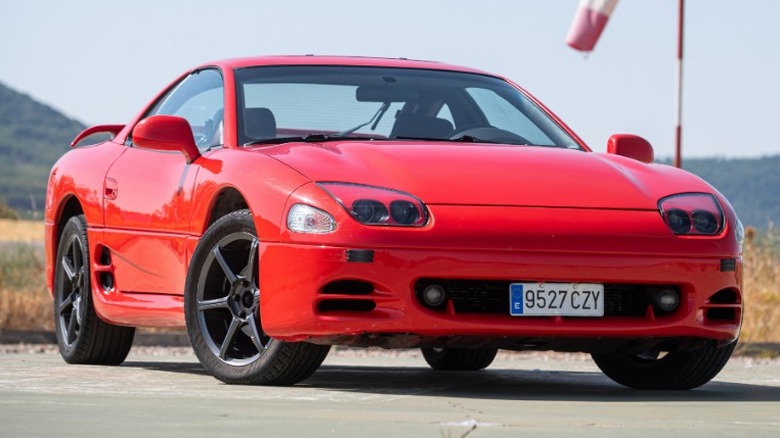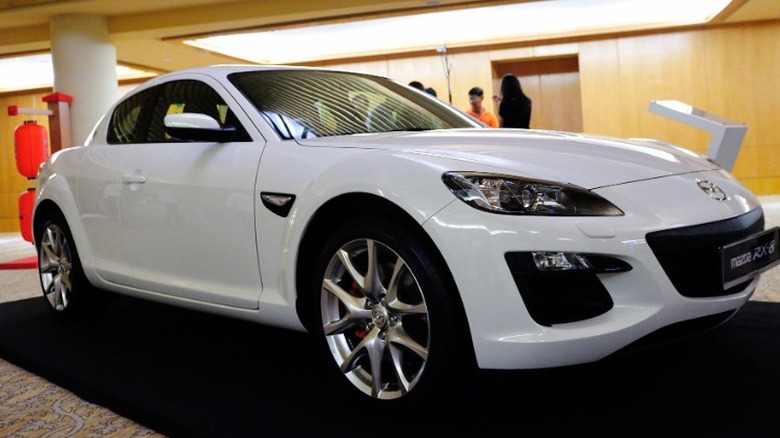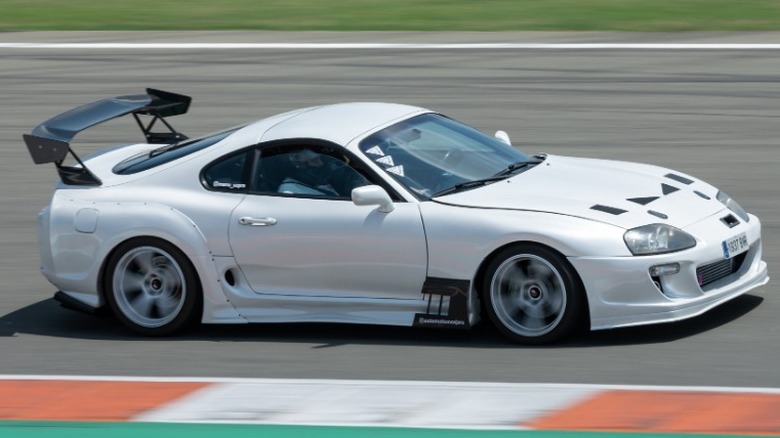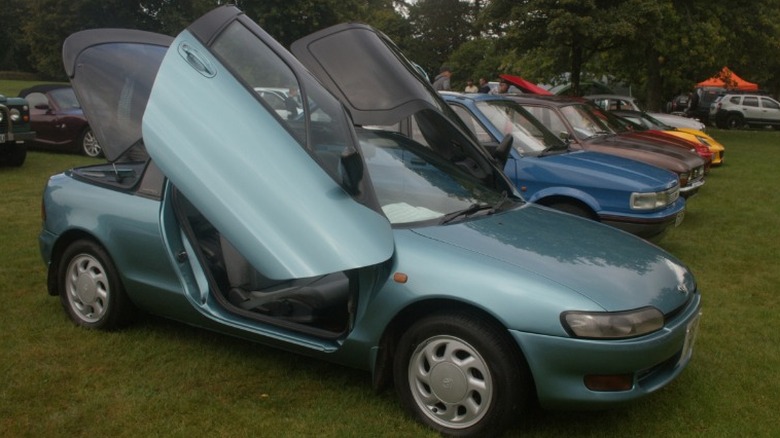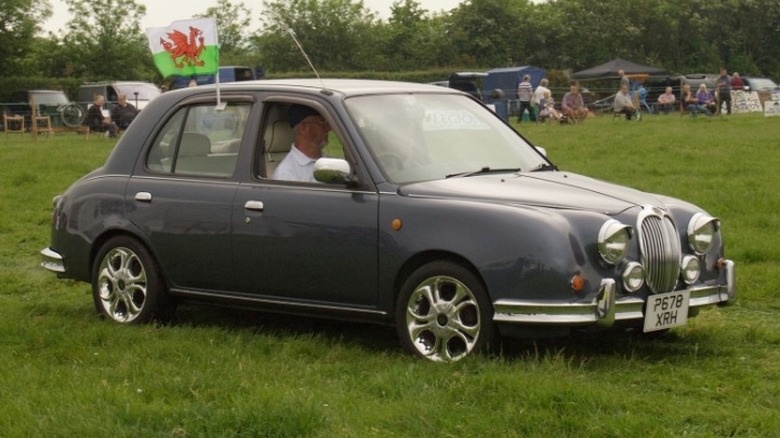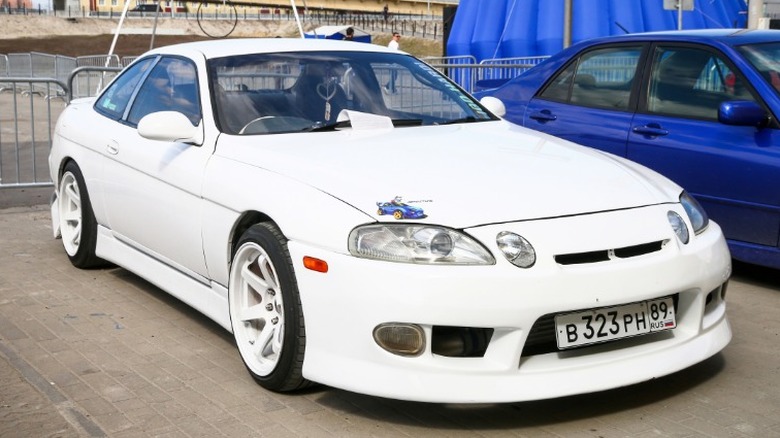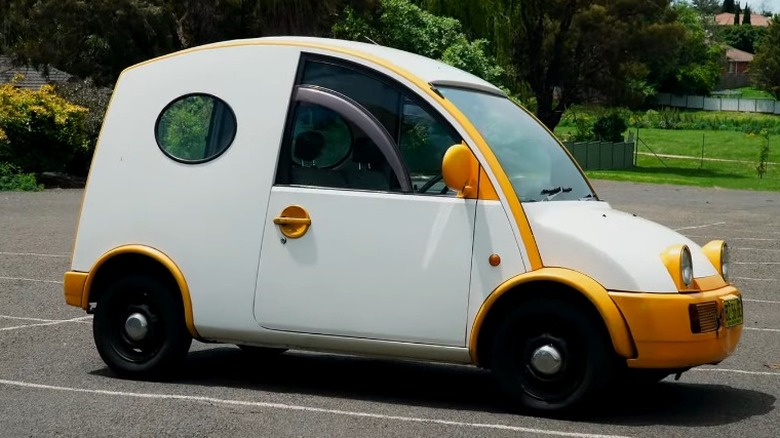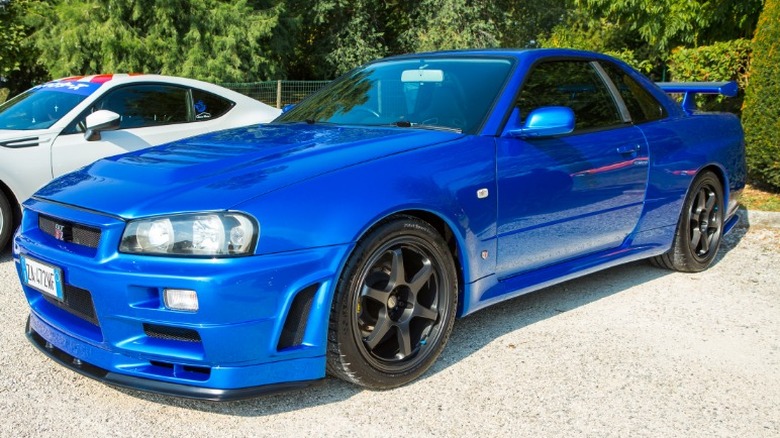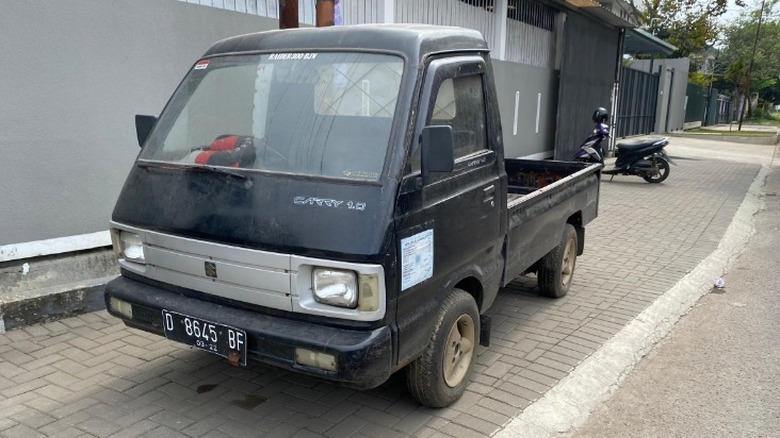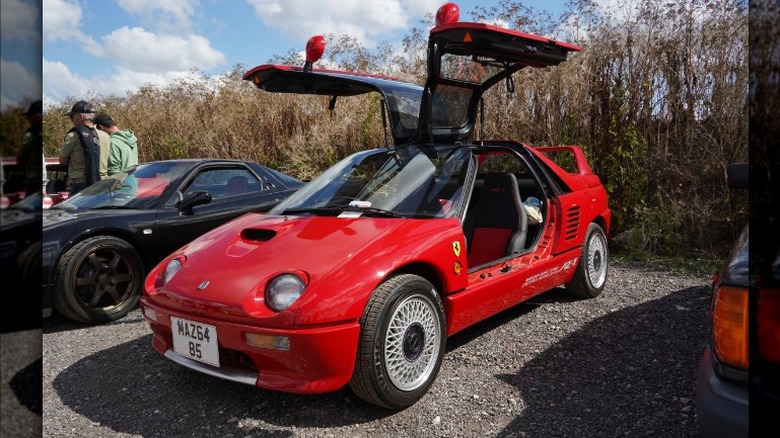Classic JDM Cars That Are A Total Waste Of Money
The Japanese auto industry is responsible for some of the most-loved car models of all time. In the early days of the post-war period, while Detroit manufacturers were churning out American classics such as the Corvette and Thunderbird, the Japanese were trying to pick up the pieces of a destroyed country and economy. The cars of this period were generally very small, efficient, and underpowered. Most were not highly desirable except to niche collectors. But as the industry grew and thrived, interesting, technologically advanced, and utterly efficient models rolled out of plants in Tokyo, Osaka, Hiroshima, and more.
Export models quickly became top sellers around the world and eventually, many sports cars and luxury models would be counted among them. Yet, certain models from every manufacturer in the country were never meant for foreign lands. These are considered to be Japanese Domestic Market, or JDM, models. From an American perspective, some of these are seen as forbidden fruit as they are unable to be imported into the country until they are at least 25 years old. Some are highly desirable cars that people spend a lot to import. They are all right-hand-drive, which poses some challenges driving in a left-hand-drive country. The thing is that the import costs along with rarity and lack of local parts support can drive up the costs significantly, and you may have to ask, is it worth it? Maybe. But then again, these classic JDM cars are a total waste of money.
Mitsubishi GTO
Mitsubishi's GTO is better known in the U.S. as the 300GT or Dodge Stealth. To be completely fair, the GTO is a very cool car and it was built at a time when Mitsubishi seemed to be doing a lot of things right. The styling is attractive and it was available with some excellent option packages, including high-performance.
The GTO was offered for sale from 1991 to 1999. The base model came with a 3.0-liter 24-valve V6 making 222 horsepower. Handling is excellent and the interior is well-trimmed and of top quality. The VR-4 delivers a very respectable 300 horsepower from its twin-turbo DOHC V6, and it sends power to all four wheels along with four-wheel-steering. With the added performance also came a curb weight of 3,826 pounds, which makes it heavier than its contemporary rival, the 3,560-pound Supra Turbo.
Despite being a great-looking car with good performance, it can be a waste of money through a stream of small repairs stemming from the inordinate amount of complex electronics. The cars were very advanced and used cutting-edge technology, but that also made them complex and prone to breaking down from one of any number of little issues building up to one giant fiasco. Add to that the extreme appreciation in the car market and the price of entry can top $50k. Unless you really know what you are getting into, this should probably sit further down on your JDM car shopping list.
Mazda RX-8
Mazda soldiered on with its unique Wankel rotary engine for decades before finally phasing it out in 2012 due to increasing standards for emissions. The final car to get the rotary was the RX-8 sports car and the engine was not the only unique thing about it. Rather than making a true four-seater or a 2+2 with nearly unusable rear seats, the RX-8 has a pillarless design that allows for small rear doors allowing access. It is also a sporty design that still looks good today.
The Renesis rotary engine is just 1.3 liters with two rotors making just 231 horsepower and a very weak 156 lb-ft of torque. The low torque may be its biggest drawback, aside from the abysmal fuel mileage of just 18 mpg. Its 50/50 weight distribution gives the cars excellent handling, and getting into the twisties is where it shines. However, the rotary engine is prone to failure and usually, only the die-hards who live and breathe triangles – the shape of the rotors – can make something of these cars worth having. The Apex seals on the corners of the rotors are highly prone to wear and the engines are easy to flood, even though they are fuel-injected.
Mazda released a couple of Japan-only special editions, including the Mazdaspeed RX-8 and the RX-8 Spirit R that might be worth importing, but mostly to rotary fans. Domestic market RX-8 cars are pretty cheap and JDM models won't be legal to import until next 2024.
Toyota Supra MkIV
The fourth generation of Toyota's premier sports car is objectively one of the best cars ever built by the Tokyo-based company. Originally a performance upgrade to the popular Celica model, the Supra became its own unique line with the third generation car in 1986 (released halfway through the model year). The fourth generation sold through 1998 in the U.S. but remained in Japan until 2002, and it demonstrated that Toyota was capable of building a highly competitive sports car that has now become an icon of Japanese motoring.
In the later years of production, the Supra was available with a twin-turbo inline-6 engine that came from the factory with 325 horsepower. This impressive power was also housed in a handsome package that came with Toyota's legendary reliability. The 2JZ 6-cylinder engine was also over-engineered, which allowed tuners to later modify the cars and that engine could easily withstand more than 500 horsepower, with many examples being pushed to more than 800.
Being in Fast and Furious and Gran Turismo elevated its status, but it is a good car without that. But it can be a waste of money. Original copies of Unmodified Supras can sell for more than $200,000 as of the time of writing. The final editions only sold in Japan will be legal for import in the next couple of years, and they are sure to be similarly unaffordable.
Toyota Sera
Many Toyota models only available domestically are also quirky and odd, but alluring. This includes the Sera, which debuted in 1990. The Sera is a cute little car that puts styling and economy at the forefront. With its 1.5-liter engine and just 108 horsepower, it's not for Saturday night drag racing and its two doors and sloping hatch cancel any plans of running the soccer team to pizza night. But it has a slick and rounded styling that marked the shift from straight lines and boxy shapes that dominated Japanese cars through the '80s. It is a quintessential '90s Japanese hatchback in almost every way. Except for the doors.
This little mostly traditional two-door hatchback employed gullwing doors for reasons unknown. They are peculiar as they extend into the roofline like a Ford GT and then swing out and forward. The glass also extends up and over the car, creating a large bubble-like canopy with small Delorean-style windows that open. The result is a surprisingly spacious interior and a one-of-a-kind hatchback style. But this unique feature is also its biggest flaw. As explained by YouTuber Doug DeMuro, the overhead glass causes the interior to get extraordinarily hot and provides no respite from the sun overhead. These are not terribly expensive, but the only genuine benefit is the novelty. With prices upwards of $10,000, it feels like a really expensive party trick that will blind you and make you sweat.
Mitsuoka Viewt
Perhaps the most strange yet enduring automotive marque from Japan is Mitsuoka, which makes retro-inspired cars from existing Japanese models. Some of them are quite interesting. They currently offer a RAV-4 resembling an old Chevy Blazer, but it is too new for import. The older catalog spans well beyond 25 years, so you can get the Viewt right now.
The Mitsuoka Viewt is the car for someone with a hankering for a classic Jaguar sedan but not the budget for it. Old Jaguar Mark 2 models can be hard to come by and they are valued by collectors, so that keeps prices up. The solution could be a Viewt, which is styled like a Mark 2 but features a Nissan March underneath.
The March was never sold in the States, but it is a supermini economy sedan powered by either a 1.0 or 1.3-liter engine backed up by a 5-speed manual or 4-speed auto transmission. 0-60 mph time is measured in minutes rather than seconds, and the interior comes with window cranks and a rearview mirror, just like the old Jag. The styling is relatively convincing and the coachwork looks to be excellent, but this car fools exactly nobody. The proportions are off and the miserly base is undeniable. The good news is that they can be bought for around $5,000, but you could find another car that is also miserable to drive for far less.
Toyota Soarer
The Toyota Soarer is a JDM car that has been part of the lineup for many years now. It debuted in 1981 and has been a model used to showcase many new technologies created by Toyota, including electronically-controlled suspension and color gauge cluster display. It first arrived with a DOHC straight-6 engine and has been a performance luxury car for Toyota from the start.
One of the most desirable models was the twin-turbo model of the late '80s, which produced 250 horsepower, an admirable output considering the 3.0-liter engine was on par with the V8 Corvette of the day. However, the Soarer would later receive the same V8 engine developed for the Lexus LS400. Furthermore, that same V8-powered car would be exported to the U.S. as the Lexus SC400. It sold reasonably well and well-kept examples of these can be found without much hassle. This would make importing an elusive JDM car an unreasonable proposition when an LHD model can likely be found in your hometown with no hassle and for less money.
Nissan S-Cargo
Nissan released several cars in its "Pike" series in the '90s that all aped classic cars of the '50s and '60s. This included the S-Cargo, which is, unsurprisingly, a cargo van with styling that resembles a snail. Whether the designer set out to create a snail van is anybody's guess. However, its design does draw inspiration from the Citroën 2CV Fourgonnette, which was the cargo version of France's popular people's car that helped get a war-torn country back up and running with simplicity and economy.
It is powered by a 1.5-liter 4-cylinder engine with about 70 horsepower, which is good enough to haul a maximum payload of 660 pounds. The interior is about as spartan as it gets, with a centrally mounted gauge cluster and single-spoke steering wheel like those that Citroën made iconic with the DS, and it has a fabric roll-away roof just like the 2CV. It has seating for four on front and rear benches, with the rear folding flat for cargo. Both seats offer little padding or comfort for long drives.
All of this adds up to a small and slow car that is cramped and uncomfortable. If not for the unique styling, it would be completely unremarkable. Except for the attention you might draw with it, it has few redeemable characteristics as something you might want to drive. In the U.S., this is essentially a toy that is little more than fun to take out and show off to your friends.
Nissan Skyline GT-R
In the world of JDM fanboys, the Nissan Skyline GT-R is an automotive god. Ever since it was featured as one of the cars in "Fast & Furious," interest has been through the roof. Despite this somewhat artificially created elevation of stature, the car stands on its own as a drool-worthy machine that anyone should want to have in their garage. It has style and, above all, loads of power with good handling.
Nissan first introduced the Skyline name while still operating as the Prince Motor Company in 1957. It gained a 6-cylinder engine in the mid-60s and Nissan took it racing. The GT-R edition appeared in 1967 and continued to be a top-performing model for Nissan ever since. The first seriously technologically advanced model arrived in 1989, aka R32 model, pushing 300 horsepower with 4-wheel steering and other electronic enhancements. These have been popular imports, but the later R33 and R34 models with increasing power and better performance are now the most wanted examples.
Skyline GT-Rs can be tuned to make an immense amount of power and they are attractive cars that retain somewhat reserved styling. But the prices are out of control now and importing the R33 and R34 as they become legal has made them financially untenable for many. Nice copies of later GT-R models can sell for $50,000 and up to $125,000 for a mint condition LHD converted car. For that much money, there are dozens of excellent American-spec Japanese cars.
Suzuki Carry (and other Kei trucks)
In Japan, a class of small cars with engine sizes limited to 660cc and 64 horsepower is called a kei car and exists to offer a vehicle with a lower tax burden. They are popular in the tightly congested country full of small and winding streets and limited parking. They have also become popular in the U.S. since the 25-year rule is now allowing the import of some of the best models from the '80s and '90s. The Suzuki Carry is a popular choice.
The Carry sports a 3-cylinder engine of just 658cc displacement and it churns out 49 brutish horsepower. It is a small truck capable of carrying a surprising amount of cargo, and the option to fold down all three sides of the bed makes it particularly versatile for oversized cargo. Like most other kei trucks, the engine sits below the cab to save space and the overall dimensions make it such that it can nearly fit in half of a typical American parking space. But it's stiff, cramped, and uncomfortable.
Prices on these are a bit erratic, but many of them show up with significant rust. Japan is mostly a coastal country after all. These can be picked up for around $5,000 but often reach $10,000 for some particular models. In some specific circumstances, these trucks can be exactly what is needed. But for most people, they are a novelty and highly impractical.
Autozam AZ-1
In the '90s, Mazda created sub-brands to differentiate select niche markets for its automobiles. Eunos, ɛ̃fini, Amati, and Autozam were set up to sell separate branded luxury cars, sports cars, and kei cars. Autozam carried the kei car line, and the most popular of all of them is the quirky and cool AZ-1.
This pint-sized sports car came with the same limited-displacement 660cc engine, but it was placed in the middle of the car behind the two passenger seats. It made 63 horsepower but was wrapped in a low and sleek package with go-kart-like handling and finished off with gullwing doors — a mini supercar with Japanese reliability. While its power is limited, the curb weight of just 1,500 pounds means performance is spry and the overall packaging makes for fun driving.
The AZ-1 came out at a bad time as Japan's economy was floundering and sales of this model fell short with fewer than 5,000 built. This makes them rare and desirable, especially as they are legal to import now. However, they are said to be twitchy and prone to oversteering. But they have become especially valuable and recent sales have brought in more than $20,000 at auction. That may be just fine for some people, but it does seem like a lot of money just to have a car with fancy doors, especially when you can get a V8-powered and very clean Fiero for much less.
